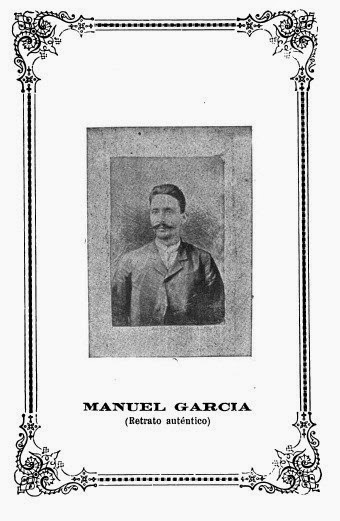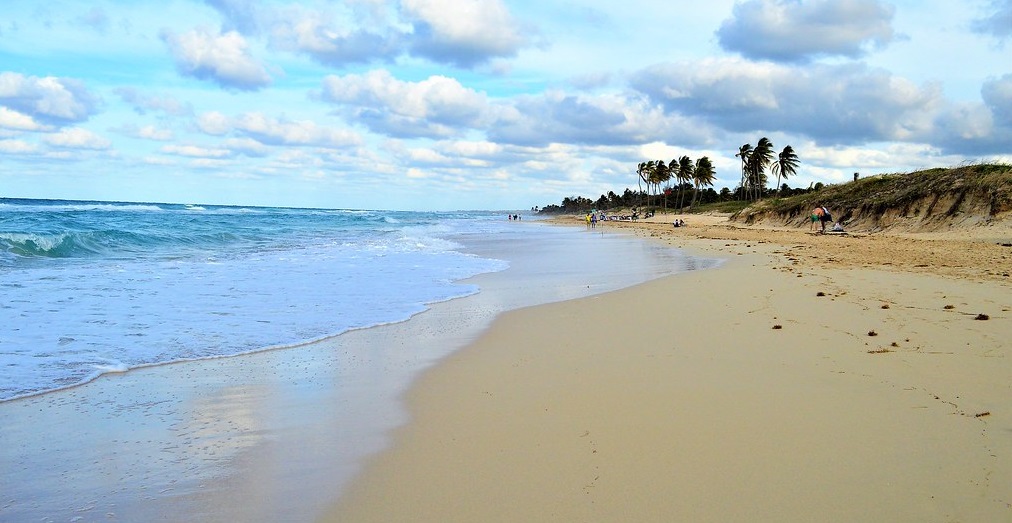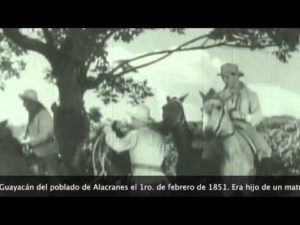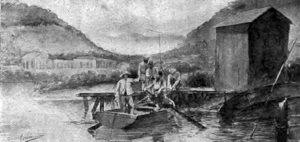 MANUEL GARCIA, “EL REY DE LOS CAMPOS DE CUBA”. PATRIOTA O BANDOLERO?.
MANUEL GARCIA, “EL REY DE LOS CAMPOS DE CUBA”. PATRIOTA O BANDOLERO?.
Manuel Garcia, sin dudas el mas famoso y conocido bandolero de la época colonial, conocido como el “Rey de los campos de Cuba”, se le conoce como aquel especie de ‘RobinHood’ que robaba a los ricos para luego repartir el botín entre los campesinos pobres.
Nacido en el Poblado de Alacranes, en la provincia de Matanzas el 1ro. de febrero de 1851, era hijo de un matrimonio campesino pobre procedente de las Islas Canarias españolas. Cuando murió el padre, su familia se trasladó a Quivicán, pero el desarrollo de sus actividades en la región habanera nunca lo limitó de contactos y relaciones con su región natal, donde poseía familiares y amigos que eran colaboradores y protectores de su partido.
A finales de la década de los 70, en medio de un guateque un alcalde de la región se obstinó en bailar con Rosario, su esposa, la muchacha se negó diciéndole que solo bailaba con su marido; el importuno usó frases humillantes por lo que Manuel lo amenazó de muerte. El acobardado funcionario, se escudó en su autoridad y lo envió a la cárcel.
Un día fue a ver a su madre que ahora vivía con José García Gallardo, un rico hacendado de la zona y viendo que ella era brutalmente golpeada por el amante sacó su afilado machete y lo hirió. El temor de que lo encarcelaran de nuevo lo hizo buscar amparo en el monte donde se vio involucrado en hechos delictivos.
Dicen que se vinculó a la pandilla de un tal Cristóbal Días, unos escriben que a la de Carlos García, otros mencionan la de Lengue Romero; lo que si todos coinciden en que Manuel García nunca olvidó su esencia, ni las miserias vividas, ni los abusos de las autoridades. Con el botín obtenido en sus fechorías, aliviaba muchos sufrimientos de las familias pobres que lo aclamaban como el “Rey de los Campos de Cuba”.
Cuando el gobernador de entonces para acabar con el bandolerismo ofrece a los cabecillas el indulto, facilidades para viajar al exterior y una gruesa suma de dinero si cesaban con su conducta, Manuel García se traslada a Cayo Hueso.
El hombre que supuestamente había robado miles de pesos no guardaba nada para sí, para vivir debió buscar empleo en la tabaquería de Eduardo Hidalgo Gato, amigo de Martí.
Para el ex bandolero su contacto con los emigrados revolucionarios hizo que su rebeldía derivara hacia la independencia. En septiembre de 1887 fue uno de los 4 integrantes de la expedición del balandro Dolphin que desembarca por Puerto Escondido, al este de La Habana.
El jefe del grupo muere en combate contra los españoles Manuel asume el mando del pequeño destacamento que pretende crear las condiciones para la guerra libertadora.
A partir de entonces apenas conocerá el reposo. Eludió cuantas celadas le tendieron las fuerzas coloniales gracias a la protección que le brindaron los guajiros, quienes le avisaban de la proximidad de los guardias y lo ocultaban en cuevas y sitios intrincados y le proporcionaban alimentos y pertrechos.
Numerosa tropa le sigue los pasos, vigilaban sus movimientos. Pero García sobresale por su inteligencia natural e intuitiva y lo ayudan sus dotes de organizador y el conocimiento absoluto que tiene del terreno en que se mueve.
Operó en lo esencial en zonas de La Habana y Matanzas. Realizaba asaltos y secuestros y pedía rescate por ellos. Los españoles sabían bien de las ideas y propósitos que lo movían. Todas las víctimas de sus secuestros han sido personas que no profesan tales ideas, que el dinero que obtiene por los rescates se emplea exclusivamente en adquirir armas y municiones y en socorrer a los campesinos”.
Manuel García Ponce “Rey de los Campos de Cuba”, temido por los españoles y terratenientes, hacendados ricos, pro coloniales; hacía tiempo estaba preparado para incorporarse a la lucha se alzó con unos cuarenta hombres y emprendió la marcha rumbo a Ibarra
La noche del 23 al 24 de febrero de 1895 se esperó, por órdenes de Antonio López Coloma y Juan Gualberto Gómez, la llegada de García. No llegó y horas después se enteraron por un periódico de que no llegaría nunca.
Manuel García, en efecto, se dirigía a Ibarra, e hizo un alto en la tienda del pueblo de Ceiba Mocha para abastecerse y, en nombre de la República de Cuba, le pidió al dueño, José Fraguera, dinero y las provisiones necesarias para sus hombres.
Cuando se disponían a continuar viaje, llegaban el sacristán de la iglesia de Jaruco Felipe Díaz de la Paz y el guardia civil del mismo pueblo Vicente Pérez, para tomar unas cervezas en la tienda. Comenzó un tiroteo. El guardia fue herido y huyó, pero el sacristán, que también estaba armado, disparó sin tino sobre el grupo cubano alcanzando a Manuel García, quien cayó muerto del caballo. Lo asesinaron.
Esta es la versión más difundida y que, con los estilos y talentos propios de cada periodista, publicaron los principales diarios en aquellos días. Jamás se precisaron los detalles. Muerte oscura y misteriosa la de ‘El Rey de los campos de Cuba’.
La prensa española en la colonia, lo presentaba como un criminal, un despiadado bandolero que aterrorizaba las llanuras matanceras y habaneras. Pero la verdadera imagen de este campesino fue que, obligado por los abusos de las autoridades y los poderosos, se alzó en los campos como bandolero y después se convirtió en mambí, abrazando la causa por la cual luchó y murió.
 MANUEL GARCIA, “THE KING OF THE FIELDS OF CUBA”. PATRIOT OR BANDOLERO ?.
MANUEL GARCIA, “THE KING OF THE FIELDS OF CUBA”. PATRIOT OR BANDOLERO ?.
Manuel Garcia, undoubtedly the most famous and well-known bandit of the colonial era, known as the “King of the fields of Cuba”, is known as that species of ‘Robinhood’ who stole from the wealthy and then distributed the booty among the poor peasants.
Born in the town of Alacranes, in the province of Matanzas the 1st. February 1851, he was the son of a poor peasant couple from the Spanish Canary Islands. When the father died, his family moved to Quivicán, but the development of his activities in the Havana region never limited him from contacts and relationships with his native region, where he had family and friends who were collaborators and protectors of his party.
At the end of the 70s, in the middle of a guateque a mayor of the region persisted in dancing with Rosario, his wife, the girl refused saying that she only danced with her husband; the importuno used humiliating phrases for which Manuel threatened him with death. The cowering official shielded his authority and sent him to jail.
One day he went to see his mother, who now lived with José García Gallardo, a wealthy landowner from the area, and seeing that she was brutally beaten by the lover, took out his sharp machete and wounded him. The fear that he would be imprisoned again made him seek refuge in the bush where he was involved in criminal acts.
They say that he joined the gang of a certain Cristóbal Días, some write that of Carlos García, others mention that of Lengue Romero; what if everyone agrees that Manuel García never forgot his essence, nor the miseries lived, nor the abuses of the authorities. With the booty obtained in his misdeeds, he alleviated many sufferings of the poor families who acclaimed him as the “King of the Fields of Cuba”.
When the governor of the time to end the banditry offered the leaders a pardon, facilities to travel abroad, and a large sum of money if they ceased their conduct, Manuel García moved to Key West.
The man who supposedly had stolen thousands of pesos kept nothing for himself, to live he had to look for a job in the tobacco shop of Eduardo Hidalgo Gato, a friend of Martí.
For the ex-bandit his contact with the revolutionary emigrants caused his rebellion to drift towards independence. In September 1887 he was one of the 4 members of the Dolphin sloop expedition that landed in Puerto Escondido, east of Havana.
The leader of the group dies in combat against the Spanish Manuel assumes command of the small detachment that aims to create the conditions for the liberating war.
From then on he will hardly know rest. He avoided how many traps the colonial forces offered him thanks to the protection provided by the guajiros, who warned him of the proximity of the guards and hid him in caves and intricate sites and provided him with food and supplies.
Numerous troops follow in his footsteps, watching his movements. But García stands out for his natural and intuitive intelligence and is helped by his skills as an organizer and his absolute knowledge of the terrain in which he moves.
It operated essentially in areas of Havana and Matanzas. He carried out assaults and kidnappings and asked for ransom for them. The Spanish knew well of the ideas and purposes that moved him. All the victims of their kidnappings have been people who do not profess such ideas, that the money they obtain from the ransoms is used exclusively to acquire arms and ammunition and to help the peasants. ”
Manuel García Ponce “King of the Fields of Cuba”, feared by the Spanish and landowners, wealthy, pro-colonial landowners; he had been prepared to join the fight for a long time and he got up with some forty men and started towards Ibarra
The night of February 23 to 24, 1895, on the orders of Antonio López Coloma and Juan Gualberto Gómez, the arrival of García was awaited. He did not arrive and hours later they found out from a newspaper that he would never arrive.
Manuel García, in effect, was going to Ibarra, and stopped at the store in the town of Ceiba Mocha to stock up and, on behalf of the Republic of Cuba, asked the owner, José Fraguera, for money and the necessary provisions for his men.
When they were preparing to continue their trip, the sacristan from the church of Jaruco, Felipe Díaz de la Paz, and the civil guard from the same town, Vicente Pérez, arrived to have some beers in the store. A shooting started. The guard was wounded and fled, but the sacristan, who was also armed, fired aimlessly at the Cuban group, reaching Manuel García, who fell dead from the horse. He was murdered.
This is the most widespread version and that, with the styles and talents of each journalist, the main newspapers published in those days. Details were never specified. The dark and mysterious death of ‘The King of the fields of Cuba’.
The Spanish press in the colony presented him as a criminal, a ruthless bandit who terrorized the Matanzas and Havana plains. But the true image of this peasant was that forced by the abuses of the authorities and the powerful, he rose up in the fields as a bandit and later became a mambí, embracing the cause for which he fought and died.
Agencies/ RHC/ Maria Calvo/ Extractos/Excerpts/ Internet Photos/ Arnoldo Varona/ www.TheCubanHistory.com
THE CUBAN HISTORY, HOLLYWOOD.











